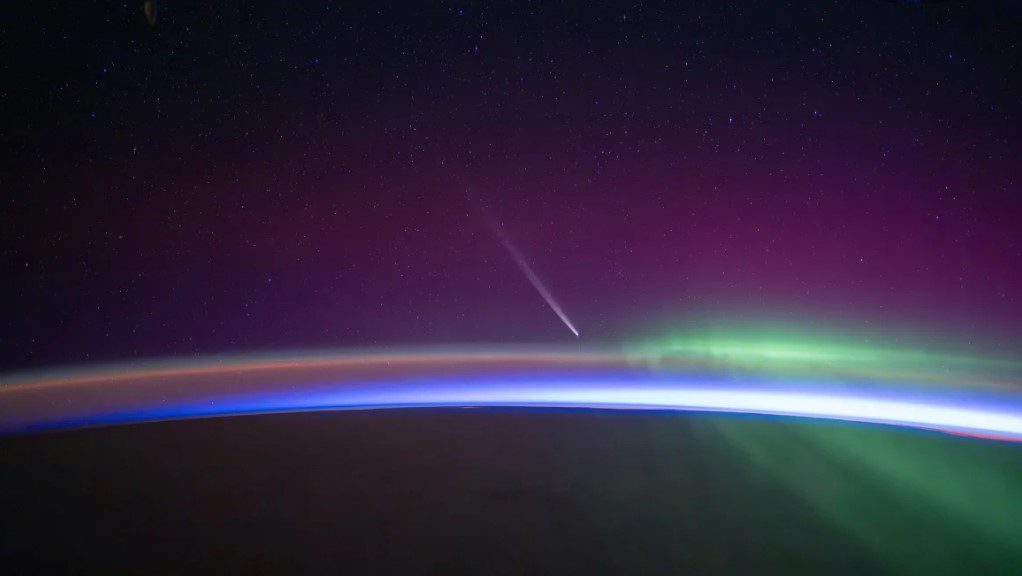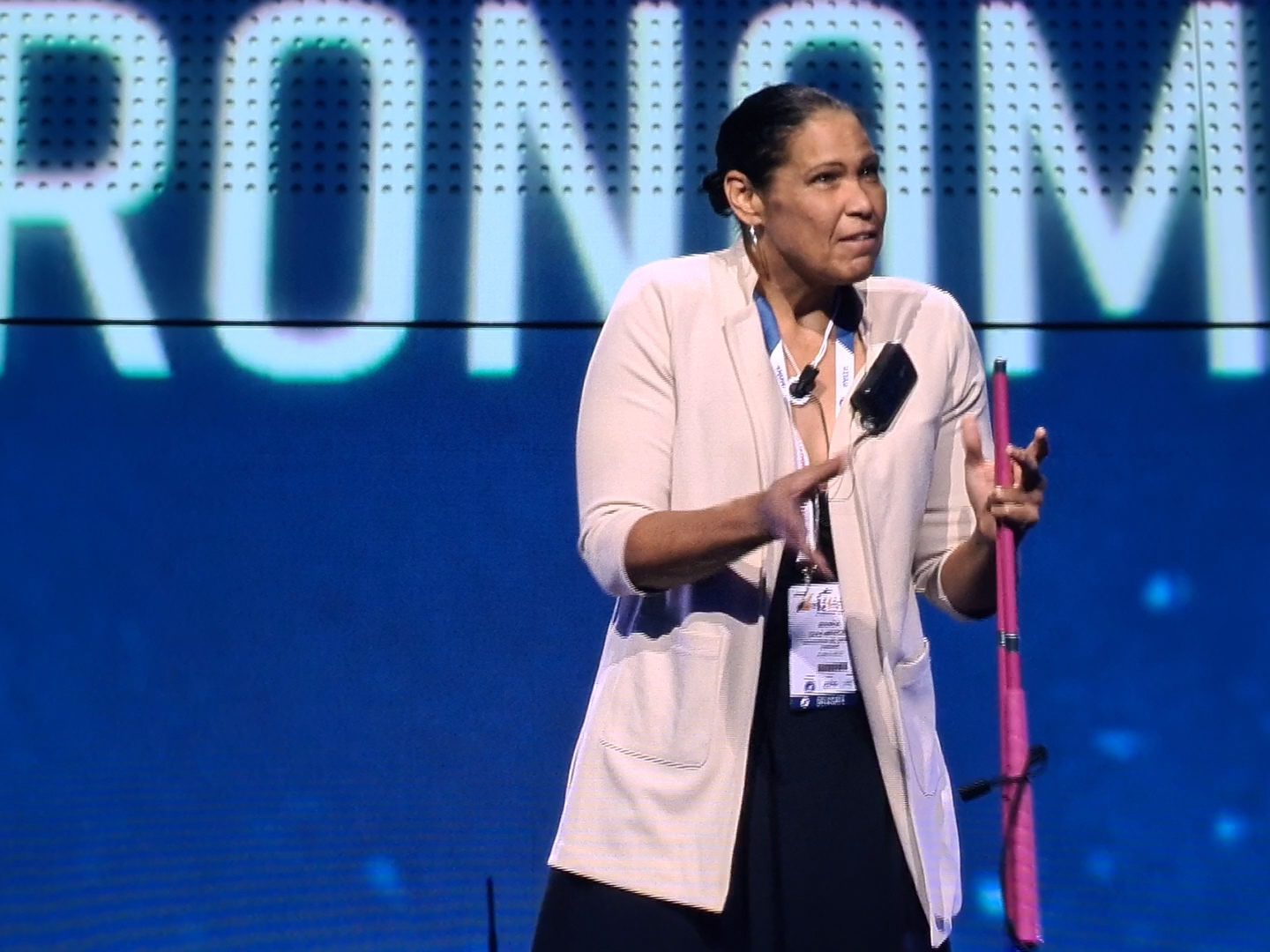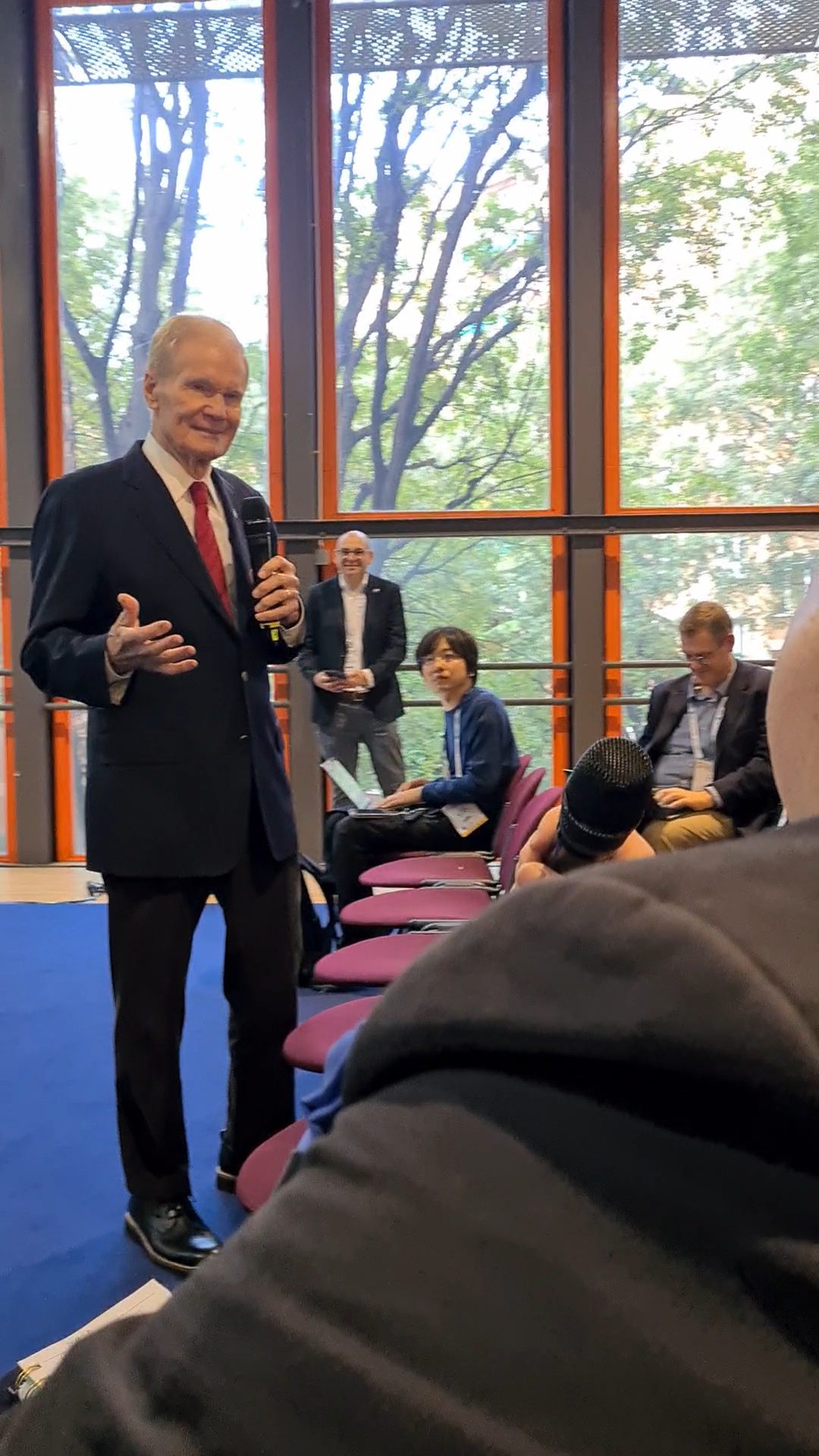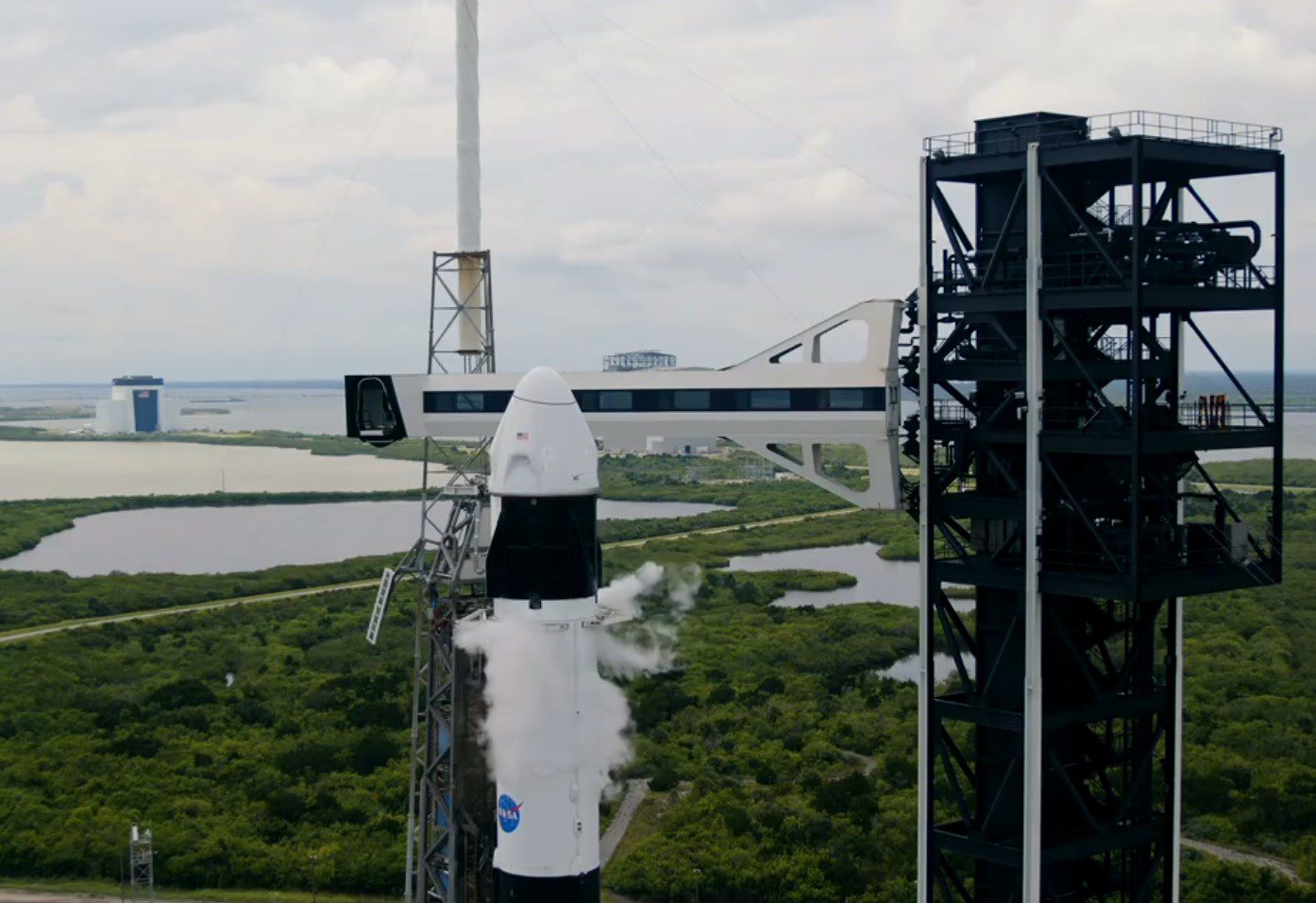With a record 11,000 attendees and over 2,000 presentations, there were too many ideas, exhibition stands, papers and talks for anyone to cover comprehensively. The sense of ‘FOMO’ (fear of missing out) was inescapable as attendees, lowly humans that we are, lack the ability to be in two places at once.
So, instead, we have selected a handful of the most intriguing, important or novel ideas that we heard at the conference.
The opening ceremony had all the expected flourishes, peppered with some fascinating facts that deftly highlighted connections between space and art. For example, paint used in ancient art that has lasted centuries, and derived from animal bones, is being applied as a protective layer for the ESA Solar Orbiter mission due to its obvious durability.
One of the most arresting talks during the ceremony came from Dr Wanda Díaz-Merced, an astronomer best known for using sonification to turn large datasets into audible sound. Her research on sound and audio in space is made more compelling by the fact that Díaz-Merced lost her sight as a young adult.
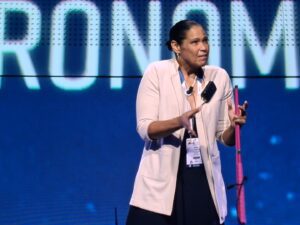
Dr Wanda Díaz-Merced demonstrated the value of studying sound in space. Courtesy: Farah Ghouri
Comparing Spaceports
Even though there are a growing number of space ports on the global market, enthusiasm for them has not been dampened. However, some are more prepared than others to handle traffic, according to Patrick McCarthy, Director of Space Florida spaceport, and Janet Tinoco, Professor Emeritus at Embry-Riddle Aeronautical University. The two have assessed every commercial space port in the world (except apparently, Sutherland – yet) and rated them according to their operational readiness. Some, such as Saxavord in Shetland, Scotland, which boasts multiple potential customers, earned a surprisingly low rating. Mind you, it has yet to conduct flights, so perhaps McCarthy and Tinoco have a point.
They also suggested some unusual ideas for locations for space ports. These could benefit communities not typically associated with the space sector, such as potentially using the land (particularly the airstrips) of native American tribes.
Separately, although in a similar vein, Geovian Stower, of the Kenya Space Agency, proposed reinstituting a launch site at, or close to, the equator in Kenya. One of the advantages of this location is that there is no need to remove the inclination for GEO missions. Additionally launches benefit from the ability to maximise the boost of the Earth’s spin.
Exploring Mars
While Mars has been in the sights of the space industry for some time, attention is turning to the practicalities of exploring and dwelling on the planet. For example, Robert Zubrin, President of the Mars Society, explained that nuclear power would be necessary for exploration by humans. Initial missions could rely on fission systems but fusion systems would be needed for settlements – the ultimate goal. The Mars exploration aficionado also explored the novel idea that there might soon be a ‘used rocket’ market, if reusable rockets become a reality.
While NASA and others try to figure how to get just a couple of astronauts onto the Moon, George Lordos, research scientist at Massachusetts Institute of Technology (MIT), thinks they should be sending large crews from the outset. For Lordos, it’s a numbers game. His analysis has shown that bigger crews – with, say, 15 astronauts – increase the chances of a mission’s success and are more cost effective than smaller Mars missions.
Decolonising Space
While platitudes were served up in the plenary sessions, something palpably daring was brewing in a room in the basement. A group of attendees gathered for the first iteration of the “Space for All: Decolonial Practices in Space” technical session. The chair, Dr Nelly Ben Hayoun-Stépanian of the California-based SETI Institute (SETI stands for search for extraterrestrial intelligence), began by acknowledging that the session would cover uncomfortable topics including, but not limited to genocide, LGBT issues and language.
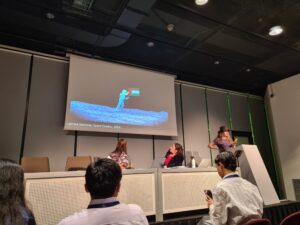
Marie-Pier Boucher, author of Space Feminisms, included a still from “A Space Exodus” – a 2009 film by Larissa Sansour
which explored the idea of the first Palestinian in space. Courtesy: Farah Ghouri
And indeed, it was. For starters, when Jahir Santos Germán, of the Instituto Politécnico Nacional, asked the audience if they thought there was a language barrier at IAC, most hands in the room went up. The Mexican pointed out that, according to his research, 98% of scientific publications are written in English – leaving one to wonder about the research and knowledge in other languages still untapped.
Isa Konga, an engineer at German aerospace startup POLARIS Spaceplanes, made a case for re-naming the Colombus Module on the International Space Station. Christopher Colombus was an Italian explorer credited with “discovering” the Americas. He is also a controversial figure because of his treatment of indigenous communities (he enslaved many native people) and his complicity in violent colonisation. Some of the engineers who worked on the Columbus Module were also at the conference. Having spoken to them, Konga said they simply did not see a problem with the module’s naming.
It was a timely topic as the first day of the IAC coincided with a federal holiday in the US also named after Colombus and mired in controversy because of it. A counter movement to rename the holiday as Indigenous Peoples’ Day, which some US states observe, has garnered more support. US President Joe Biden gave it his approval in 2021 with the first presidential proclamation of Indigenous Peoples’ Day to “honor America’s first inhabitants and the Tribal Nations that continue to thrive today”.
Asked for alternative names for the Colombus module, Konga referred to other spacecraft, such as the Japanese Kibō module – also on the ISS – which translates to “hope”, as an example of a name that puts humanity at its centre.
Sahba El-Shawa, Director of the Jordan Space Research Initiative (JSRI) – and the first female Palestinian analog astronaut – addressed the jarring dual applications of space technology. Innovations are designed for both civil and military purposes. To show how deep the ties run, El-Shawa created a database that documents some of the ties between the military industry and space organisations with the example of Gaza. Through her think-tank and policy research hub, the Palestine Space Institute, El-Shawa advocates for the decoupling of space from the military-industrial complex.
Comment by Farah Ghouri: Many in the sector will roll their eyes at the inclusion of this technical session – and that is exactly why it was imperative. Nowhere else in the entire conference was the human cost of the intimate relationship between the space industry and defence discussed. We at Seradata applaud the inclusion of this technical session and we look forward to future iterations of it – but please don’t relegate it to the basement next time. Put it in the main auditorium, where it belongs.
Slingshot contributions
Insurance loss
David Todd, Lead Analyst at Slingshot Aerospace and a reporter for SSI, gave an interactive presentation on insurance losses and anomalies. Power was the largest cause of in-orbit insurance losses over the last 20 years. However, of the top 10 insurance losses by value, four were related to antennas/beams, according to Todd’s investigation. His presentation was one of three shortlisted in the Launch Infrastructure category out of over 1,700 presentations submitted across all themes.
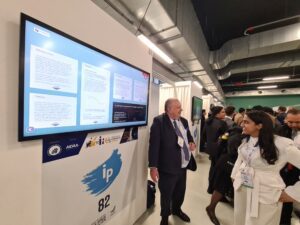
David Todd’s presentation on insurance losses and anomalies was shortlisted for the prize for the best in his category. Courtesy: Farah Ghouri
Todd also presented a technical paper analysing the causes and consequences of launch vehicle failures over the past 20 years, which pinpointed engines and propellant lines as a frequent weak spot for rockets. His analysis of information from the Slingshot Seradata database showed that launch failure rates are reduced by two things: experience and reusability.
Connecting sustainability, space and defence
Sustainability and defence are not a natural or obvious fit, yet the former is a buzzword and the latter an industry catalyst. How does one make sense of this potentially strained relationship?
Kerri Mertz, Director of International Business at Slingshot Aerospace, which owns Seradata Space Intelligence, suggested one way to square the two. Increasing debris means spacecraft are increasingly compelled to move out of the way to avoid potentially fatal damage. However, spacecraft use more of their propellant and lifespan in doing so. So, whether friend or foe, Mertz stressed that it is in everyone’s interest to reduce space debris.
David Todd contributed to this report



